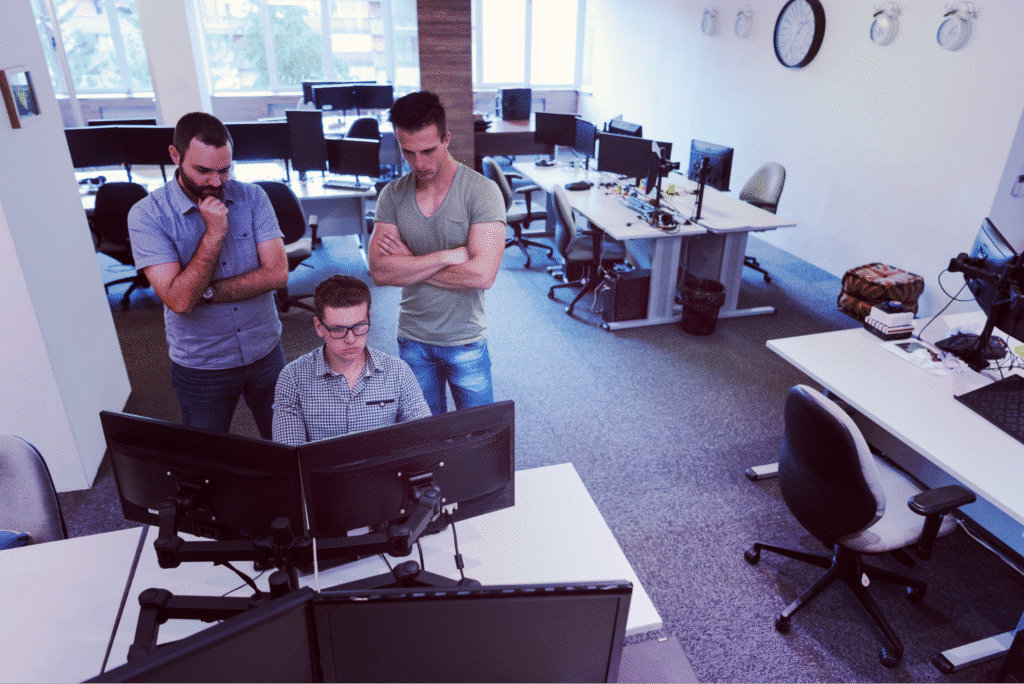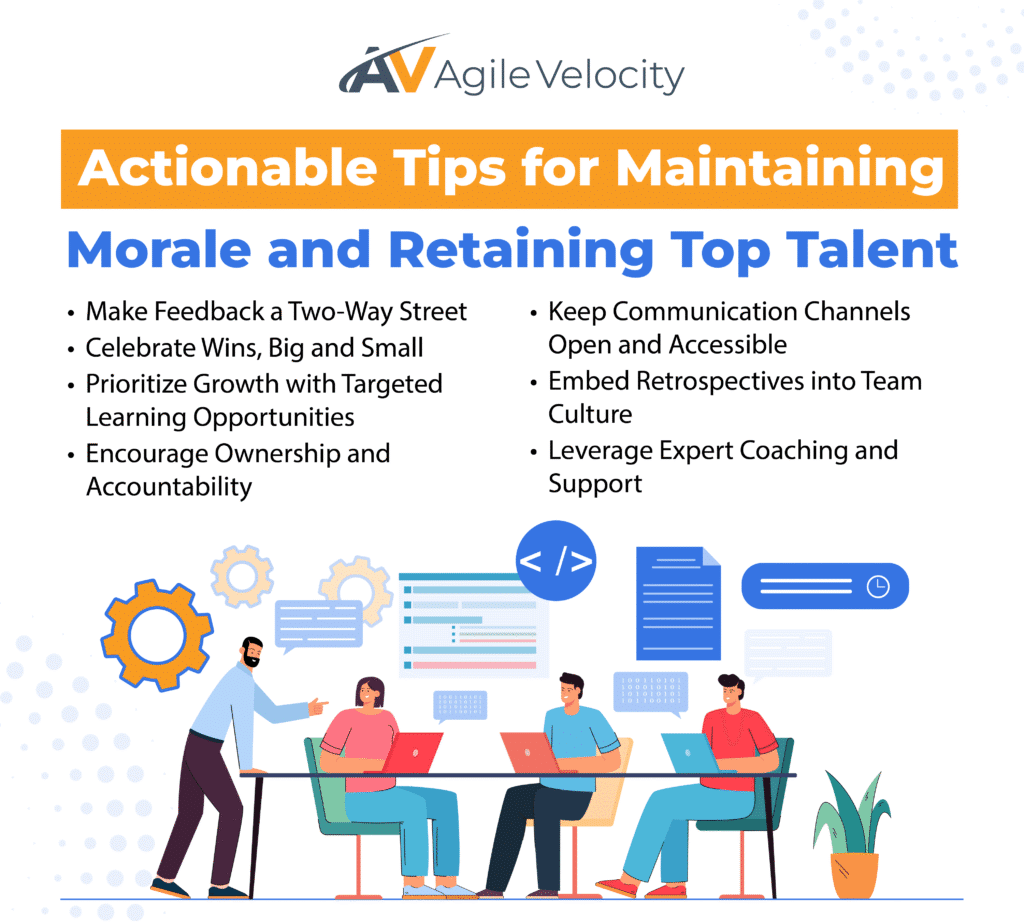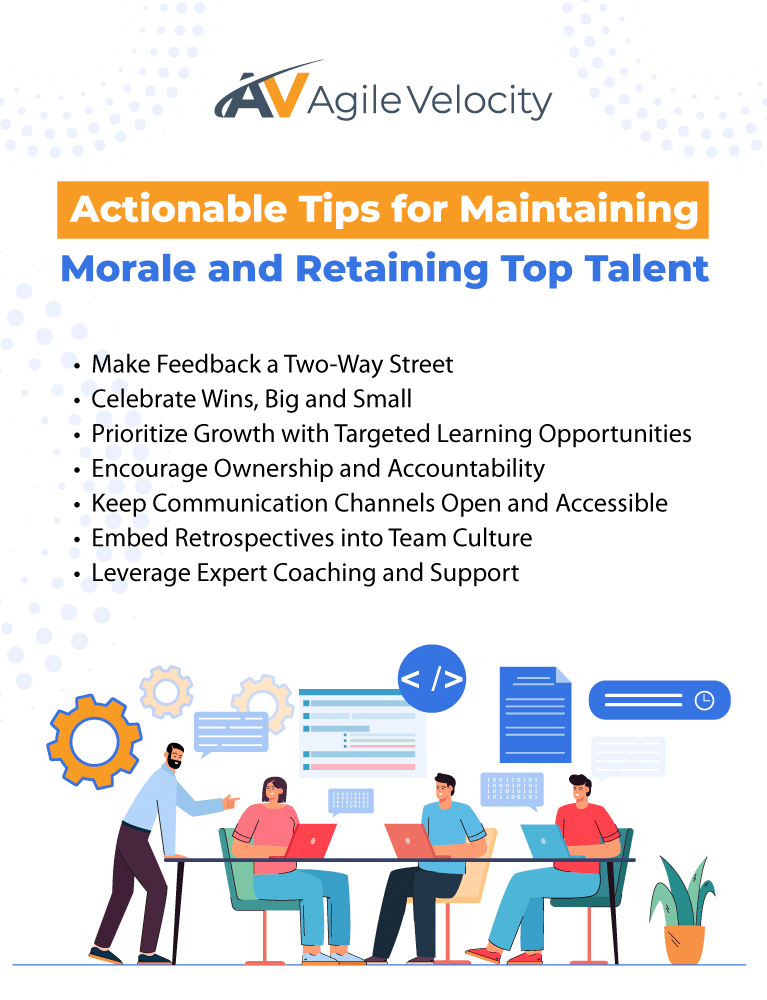Creating software requires more than technical expertise—it thrives on teamwork, innovation, and problem-solving. When a team feels valued, supported, and motivated, they deliver exceptional results. However, the constant pressures of strict deadlines, evolving priorities, and increasing stakeholder demands can easily erode software team morale, impacting overall performance.
For Agile Development Managers, these challenges often come alongside pressing issues such as retaining top talent, bridging skill gaps, and fostering team engagement.
This article explores how you can boost software team morale by cultivating a collaborative work culture, recognizing individual contributions, and leveraging Agile best practices. You’ll learn how Agile retrospectives can inspire regular team alignment, how to address skill gaps thoughtfully, and how to incorporate recognition into your team’s routine. Additionally, we’ll show how Agile Velocity’s expertise and tools—such as Path to Agility® Navigator—can support your journey toward higher team engagement, productivity, and retention.
Understanding the Impact of Low Morale and High Turnover

Low morale can quietly undermine your team’s success by hindering productivity, innovation, and long-term stability. When developers feel disengaged or undervalued, their focus wanes, code quality suffers, and deadlines may slip. Miscommunications and a reluctance to share new ideas become commonplace, stifling creativity and teamwork. These patterns not only affect immediate outputs but also create a work environment where team members feel stuck or unsupported, increasing the likelihood of burnout. Disengagement, left unchecked, can evolve into frustration, driving top talent to look elsewhere for opportunities where they feel more appreciated.
High turnover intensifies these struggles. Onboarding new team members is often a lengthy and costly process, and the departure of experienced developers can drain the team of vital institutional knowledge. Each time someone leaves, it disrupts momentum, slows progress, and risks further demoralizing remaining team members. Some industry analyses indicate that in the technology sector, turnover rates may average around 13.2%—a level that diverts time and resources away from proactive improvements toward continual hiring processes. In addition, research suggests that frequent departures can have significant intangible costs, such as diminishing team morale and cohesion.
Conversely, a team with high engagement levels and strong morale is better equipped to overcome these challenges. When team members feel supported, they stay aligned with project goals and maintain steady progress, contributing to on-time, high-quality software deliveries.
By prioritizing team satisfaction and creating an environment where developers can contribute, learn, and grow, you can foster loyalty while significantly reducing the friction caused by high turnover. Addressing morale and engagement early doesn’t just improve productivity—it also sets the foundation for a resilient, motivated, high-performing team.
Building a Collaborative and Positive Work Environment
Creating a collaborative and positive work environment begins by fostering open communication and promoting a shared sense of ownership among team members. When developers feel comfortable asking questions, sharing ideas, or voicing concerns, they naturally become more engaged in the success of the team. A safe, supportive atmosphere builds trust between individuals, making everyone feel valued for their unique contributions.
Collaboration also shines during problem-solving sessions. Practices such as Retrospectives in Scrum or visualizing your workflow in Kanban, help focus a team on continuously improving how they work. These Agile frameworks encourage transparent workflows, ensuring collaboration becomes a natural part of day-to-day operations. Ultimately, by aligning on goals and supporting one another, your team can lay the groundwork for sustained engagement, creativity, and productivity.
The Role of Recognition in Team Engagement
QUOTE: Incorporating recognition into your routine doesn’t have to be complex. Even small acknowledgments can have a big impact.
Recognition plays a vital role in amplifying team morale and fostering a motivated workforce. When individual efforts and accomplishments are consistently acknowledged, team members feel valued and appreciated. On the other hand, when hard work goes unnoticed, it can lead to disengagement and a reluctance to contribute beyond the bare minimum. Studies on employee engagement show that regular acknowledgment can significantly bolster morale and motivation across teams.
Incorporating recognition into your routine doesn’t have to be complex. Even small acknowledgments can have a big impact. A simple “well done” in a team chat for solving a tough problem or a quick praise during a Sprint Review for a successful feature launch can make developers feel appreciated. Some teams find success by dedicating time for recognition during formal events—a space where colleagues can highlight each other’s efforts. This approach promotes a culture of positivity, deepens relationships, and strengthens collaboration.
At Agile Velocity, recognition is viewed as a key lever in driving engagement. Their approach focuses on making recognition a regular part of daily interactions, fostering growth and teamwork rather than blame or criticism. This culture shift encourages teams to prioritize learning opportunities and shared accountability. By weaving recognition into everyday conversations, Agile Velocity helps organizations create an environment where individuals feel empowered to innovate and excel.
Using Agile Retrospectives to Improve Dynamics and Productivity
Agile retrospectives are invaluable sessions that empower teams to reflect, adapt, and grow. Held at the conclusion of each Sprint, these events allow teams to evaluate recent work. By pinpointing what went well and identifying areas for improvement, the team can brainstorm ways to enhance collaboration and efficiency moving forward. According to Atlassian, Agile retrospectives are a vital mechanism for continuous feedback, which helps boost team productivity.
The real power of retrospectives lies in their ability to uncover hidden challenges. Teams can address roadblocks, refine workflows, and leverage their strengths rather than wait for issues to escalate. By encouraging open feedback within a psychologically safe space, retrospectives nurture trust, transparency, and mutual accountability. Skilled facilitation is essential to ensure conversations stay constructive and outcome-focused. Agile Velocity’s facilitators help teams extract actionable insights, maintain balanced participation, and drive improvements that align with broader organizational goals.
Retrospectives also provide a platform to celebrate achievements and highlight individual and team contributions. This practice reinforces positive behaviors and fosters a mindset of continuous learning. By turning friction points into learning opportunities, the team maintains a steady momentum toward higher engagement and stronger results.
Addressing Talent Retention and Skill Gaps
QUOTE: By focusing on specific pain points—whether they are technical skills, communication hurdles, or workflow bottlenecks—leaders can address weaknesses before they escalate.
Retaining top talent is crucial in an industry where specialized skills are in high demand and opportunities abound. Additionally, unresolved skill gaps can overstretch developers and hinder project outcomes. These factors can cause frustration and burnout, paving the way for higher attrition.
To combat this, organizations must adopt a proactive approach that empowers their talent, encourages learning, and fosters a culture of growth. Providing Agile training workshops or investing in technical skill development programs can help bridge knowledge gaps while demonstrating a commitment to employee growth. Pairing less experienced developers with seasoned mentors is another effective strategy, allowing knowledge to be transferred in real time while also strengthening relationships.
Agile Velocity’s Path to Agility Navigator offers a clear lens into areas that need improvement and tracks progress over time. By focusing on specific pain points—whether they are technical skills, communication hurdles, or workflow bottlenecks—leaders can address weaknesses before they escalate. This approach keeps employees engaged in their roles and confident in their career development. Ultimately, when team members see their growth aligned with organizational goals, they’re more likely to stay, further reinforcing the team’s collective expertise and resilience.
Agile Practices for High-Performing Teams
High-performing teams don’t just happen; they are intentionally built through effective processes, well-defined roles, and supportive tools. Agile practices, such as those from the Scrum framework, SAFe, Lean and Kanban, provide proven ways to align efforts, adapt quickly, and consistently deliver value.
Scrum emphasizes iterative development with clear roles like Scrum Master and Product Owner. Sprints offer structure and frequent checkpoints. Through events like Sprint Planning and Sprint Retrospectives, teams maintain steady progress and refine their approach. For larger, more complex initiatives, SAFe offers a robust structure to scale Agile practices across multiple teams while maintaining organizational alignment. Using key elements like Planning Intervals and Iteration Objectives, SAFe frameworks empower teams to stay coordinated on shared objectives.
Kanban, on the other hand, excels at visualizing workflows and maintaining continuous delivery without rigid time-boxing. By limiting Work In Progress (WIP) items and organizing tasks on a Kanban Board, teams can reduce bottlenecks and stress caused by context-switching. This transparency also allows developers to see how tasks progress and step in when help is needed.
Another core tenet of these methods is the emphasis on periodic reflection. Whether through Sprints in Scrum or Iterations in SAFe, teams routinely assess their own performance, spot inefficiencies, and propose solutions. This loop of frequent feedback and adaptation ensures both productivity and engagement remain strong.
Agile Training and Coaching to Foster High-Performing Teams
QUOTE: Agile coaching provides tailored, ongoing support as teams navigate the nuances of applying new concepts
Building a high-performing software team requires more than introducing frameworks—it demands continuous learning, consistent practice, and expert guidance. Agile training and coaching are vital in helping teams embed Agile principles into daily work.
Agile training introduces teams to essential concepts such as collaboration, adaptability, and iterative delivery. These sessions also explore advanced topics like Lean Portfolio Management and Scaled Agile Framework® (SAFe®), as well as methods like Extreme Programming (XP), equipping your team with the knowledge to handle complex projects. Investing in learning shows developers that their growth matters, preventing stagnation and boosting motivation.
Agile coaching provides tailored, ongoing support as teams navigate the nuances of applying new concepts. Coaches offer actionable insights—whether by observing interactions during Daily Scrum sessions, advising leaders on improved backlog prioritization, or helping teams identify small but impactful changes to workflows. This personalized guidance ensures sustainable improvement, an adaptable mindset, and a cohesive Agile culture.
Through Agile training and coaching, teams gain both the hands-on techniques and the mindset to adapt to new challenges, continuously improve, and deliver high-quality results. Agile Velocity offers trainers and coaches who partner with you at each phase of your Agile journey, ensuring that processes align with business goals and that teams remain enthusiastic and collaborative.
Introducing Agile Velocity as Your Trusted Partner
When navigating the challenges of building and sustaining high-performing software teams, Agile Velocity stands out as a dependable partner for Agile Development Managers. Unlike one-size-fits-all approaches, Agile Velocity focuses on delivering outcomes that enhance value delivery, accelerate feedback loops, and strengthen talent development. Their expertise in organizational agility has supported renowned enterprises like Southwest Airlines and Texas Mutual Insurance, proving their ability to create tailored solutions at scale.
What makes Agile Velocity different is their approachable, collaborative style, enabling teams to embrace change with confidence. Their services include Agile Coaching, Lean Portfolio Management, and SAFe Agile Transformation—each designed to instill Agile practices that drive sustainable success. As the creators of Path to Agility Navigator, Agile Velocity also offers a powerful tool to help organizations identify the most impactful steps toward improvement, whether addressing skill gaps, aligning teams, or boosting software team morale.
Agile Velocity’s Agile Coaching services provide actionable support for cultivating this type of environment. Expert coaches work alongside teams to identify and implement frameworks that encourage collaboration, such as Sprint Planning events or the Daily Scrum. Through guided observation and feedback, they help teams refine how they interact, ensuring every voice is heard and respected. For example, coaches may suggest pairing junior developers with senior team members to tackle complex tasks, turning potentially isolating challenges into opportunities for shared learning.
Partnership with Agile Velocity is about more than just frameworks—it’s about creating lasting results. They prioritize trust, transparency, and collaboration, ensuring teams and leaders feel supported throughout their Agile transformation journey. With a proven track record, Agile Velocity demonstrates a commitment to fostering organizational agility that endures, empowering teams to thrive long after the initial transformation.
Elevate Your Software Team Engagement with Expert Guidance
Your software team’s morale is the backbone of consistent, high-quality product delivery. A motivated, engaged team collaborates more effectively and stays united behind shared goals.
By implementing these strategies, you can create a work environment where morale remains high, engagement flourishes, and top talent stays loyal. Taking deliberate steps to empower your team establishes the foundation for sustained productivity, collaboration, and success.
By nurturing a positive work environment where open communication, regular recognition, and continuous improvement via Agile retrospectives are the norm, you build a culture where developers feel empowered and valued.
If challenges such as skill gaps, low engagement, or high turnover are impacting your team, Agile Velocity is here to help through customized support to drive meaningful, sustainable change. Ready to unlock your team’s full potential, retain top talent, and build a thriving environment for long-term success? Contact Agile Velocity today.





